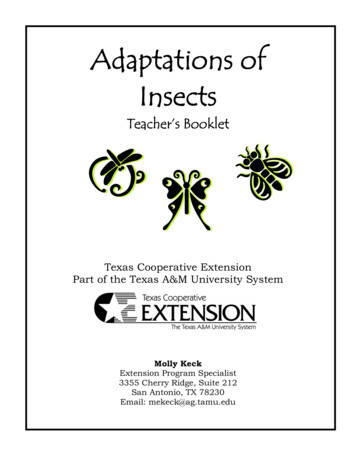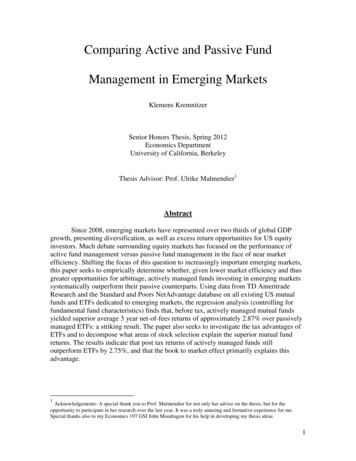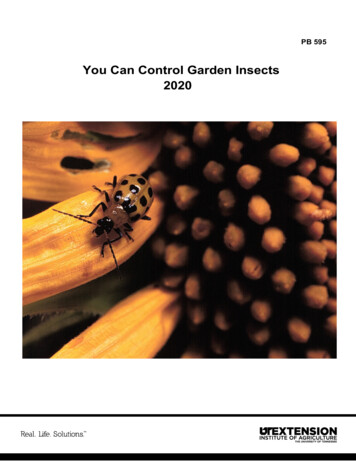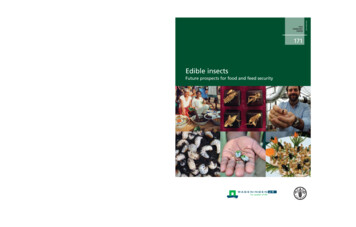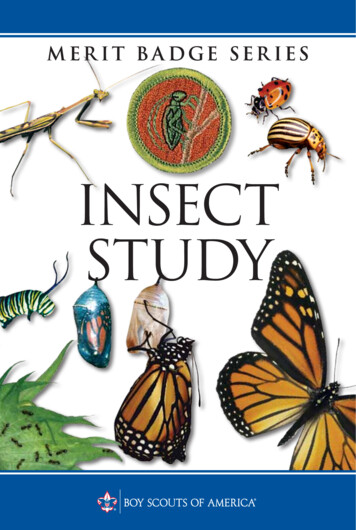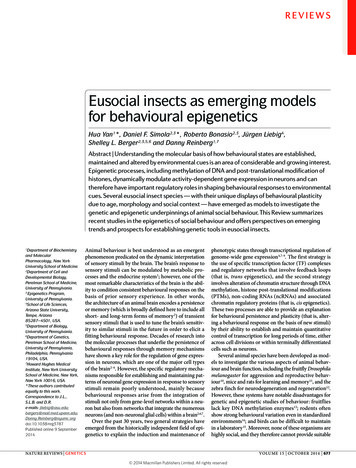
Transcription
REVIEWSEusocial insects as emerging modelsfor behavioural epigeneticsHua Yan1*, Daniel F. Simola2,3*, Roberto Bonasio2,3, Jürgen Liebig4,Shelley L. Berger2,3,5,6 and Danny Reinberg1,7Abstract Understanding the molecular basis of how behavioural states are established,maintained and altered by environmental cues is an area of considerable and growing interest.Epigenetic processes, including methylation of DNA and post-translational modification ofhistones, dynamically modulate activity-dependent gene expression in neurons and cantherefore have important regulatory roles in shaping behavioural responses to environmentalcues. Several eusocial insect species — with their unique displays of behavioural plasticitydue to age, morphology and social context — have emerged as models to investigate thegenetic and epigenetic underpinnings of animal social behaviour. This Review summarizesrecent studies in the epigenetics of social behaviour and offers perspectives on emergingtrends and prospects for establishing genetic tools in eusocial insects.Department of Biochemistryand MolecularPharmacology, New YorkUniversity School of Medicine.2Department of Cell andDevelopmental Biology,Perelman School of Medicine,University of Pennsylvania.3Epigenetics Program,University of Pennsylvania.4School of Life Sciences,Arizona State University,Tempe, Arizona85287–4501, USA.5Department of Biology,University of Pennsylvania.6Department of Genetics,Perelman School of Medicine,University of Pennsylvania,Philadelphia, Pennsylvania19104, USA.7Howard Hughes MedicalInstitute, New York UniversitySchool of Medicine, New York,New York 10016, USA.*These authors contributedequally to this work.Correspondence to J.L.,S.L.B. and D.R.e‑mails: einberg@nyumc.orgdoi:10.1038/nrg3787Published online 9 September20141Animal behaviour is best understood as an emergentphenomenon predicated on the dynamic interpretationof sensory stimuli by the brain. The brain’s response tosensory stimuli can be modulated by metabolic processes and the endocrine system1; however, one of themost remarkable characteristics of the brain is the ability to condition consistent behavioural responses on thebasis of prior sensory experience. In other words,the architecture of an animal brain encodes a persistenceor memory (which is broadly defined here to include allshort- and long-term forms of memory 2) of transientsensory stimuli that is used to tune the brain’s sensitivity to similar stimuli in the future in order to elicit afitting behavioural response. Decades of research intothe molecular processes that underlie the persistence ofbehavioural responses through memory mechanismshave shown a key role for the regulation of gene expression in neurons, which are one of the major cell typesof the brain2–6. However, the specific regulatory mechanisms responsible for establishing and maintaining patterns of neuronal gene expression in response to sensorystimuli remain poorly understood, mainly becausebehavioural responses arise from the integration ofstimuli not only from gene-level networks within a neuron but also from networks that integrate the numerousneurons (and non-neuronal glial cells) within a brain2,6,7.Over the past 30 years, two general strategies haveemerged from the historically independent field of epigenetics to explain the induction and maintenance ofphenotypic states through transcriptional regulation ofgenome-wide gene expression4,7–9. The first strategy isthe use of specific transcription factor (TF) complexesand regulatory networks that involve feedback loops(that is, trans epigenetics), and the second strategyinvolves alteration of chromatin structure through DNAmethylation, histone post-translational modifications(PTMs), non-coding RNAs (ncRNAs) and associatedchromatin regulatory proteins (that is, cis epigenetics).These two processes are able to provide an explanationfor behavioural persistence and plasticity (that is, altering a behavioural response on the basis of new stimuli)by their ability to establish and maintain quantitativecontrol of transcription for long periods of time, eitheracross cell divisions or within terminally differentiatedcells such as neurons.Several animal species have been developed as models to investigate the various aspects of animal behaviour and brain function, including the fruitfly Drosophilamelanogaster for aggression and reproductive behaviour 10, mice and rats for learning and memory 11, and thezebra finch for neurodegeneration and regeneration12.However, these systems have notable disadvantages forgenetic and epigenetic studies of behaviour: fruitflieslack key DNA methylation enzymes13; rodents oftenshow strong behavioural variation even in standardizedenvironments14; and birds can be difficult to maintainin a laboratory 15. Moreover, none of these organisms arehighly social, and they therefore cannot provide suitableNATURE REVIEWS GENETICSVOLUME 15 O CTOBER 2014 677 2014 Macmillan Publishers Limited. All rights reserved
REVIEWSSocial behavioursThe interactions amongindividuals of the same species,for example, collaborationwithin a well-defined groupsuch as a colony of eusocialinsects.PolyethismVariation in the allocation ofnest-related tasks amongindividuals in a colony.Polyethism typically refersto the special case ofage-dependent changes in anindividual’s behaviour (that is,age-dependent or temporalpolyethism); however, it moregenerally denotes differencesin behaviour associated withcaste (that is, temporal as wellas morphological or physicalpolyethism).experimental paradigms for the large variety of complexsocial behaviours seen in other species. By contrast, thespecies-rich group of eusocial insects (including all antsand termites, as well as some bees and wasps) showmany of the most fascinating, complex and enigmaticdisplays of animal behaviour.Although individual eusocial insects exhibit behaviours that reflect ‘simple’ antagonistic or adaptiveresponses (for example, fight or flight)16, they also displaymuch more sophisticated behaviours elicited by cooperative interactions among individuals within a social groupor a colony setting, such as nursing, foraging, nest maintenance, defence and policing. The regulation of suchcooperative colonial behaviours (that is, polyethism (alsoknown as division of labour)) is a central feature of moreadvanced forms of sociality (BOX 1) and often involvesthe strict allocation of behaviours to qualitatively distinctgroups of individuals (denoted as castes) that may varyby age or morphology. The existence of behaviourallyspecialized castes in particular underscores the relevanceof eusocial insects for behavioural epigenetics research. ToBox 1 An overview of insect socialityPart of our fascination with social insects stems from their capacity to learn and executecomplex decisions not only as individuals but also as integrated social groups136 — arare trait in the animal kingdom. Indeed, the best-studied and most sophisticated formsof social behaviour are highly restricted taxonomically and are mainly, although notexclusively, found in the eusocial insect orders Hymenoptera (which includes all antsand some bees and wasps) and Blattodea (which comprises all termites)22,44. Eusocialityis also found in select species outside insects, including snapping shrimps and nakedmole rats.Eusociality is considered to be the most complex form of sociality and is defined asthe cooperative care of offspring, which are born from reproductive individuals but arereared by non-reproductive individuals with overlapping generations within a colony.Eusociality and other types of sociality (such as communal, quasisocial and semisocialsociality) are likely to have derived from a simpler form of subsociality, which isgenerally characterized as the display of transient parental brood care137. Eusocialitymay be found in simple societies with a few monomorphic members and basic divisionof labour (for example, Lasioglossum albipes and Polistes metricus), as well as in complexsocieties that contain thousands to millions of workers that show highly specialized andpolymorphic division of labour (for example, Apis mellifera, Camponotus floridanusand Reticulitermes flavipes) (BOX 2).In the insect order Hymenoptera, the state of eusociality has evolved more than 10times since its first advent in the Cretaceous geological period 150 million years ago.By contrast, eusociality has evolved only once in the equally old (if not older) termitelineage (Blattodea: Isoptera)44,138. It was previously assumed that sociality in ants wasderived from their wasp-like ancestors, whereas bees constituted an independentlyevolved eusocial lineage. However, recent phylogenomic analyses indicate that ants,bees and social wasps may share a common ancestor139,140. Notably, sociality inhymenopteran lineages has evolved to qualitatively different degrees137 and hasinvolved lineage-specific adaptations at multiple scales of genomic organization39.In Hymenoptera, a typical colony contains haploid males and diploid females,which are grouped into reproductive (queen) and non-reproductive (worker) castes.The worker caste may be divided further into morphological subcastes, such as minorworkers and major workers (also known as soldiers). Additional worker subcastes (forexample, media and super-soldiers) exist in few ant species, including leaf-cutters(genera Atta and Acromyrmex) and some Pheidole species. Caste and subcastedifferentiation normally occurs during larval development, whereas furtherbehavioural differentiation occurs in adults. In an unusual example of reproductiveplasticity, workers in some ponerine ant species, such as Harpegnathos saltator, cansupersede morphological queens by becoming gamergates (that is, mated egg-layingworkers recognized as primary reproductives by remaining workers).this end, key aspects of the brain and the central nervous system, including gross morphology and neuronalconnectivity, have been extensively characterized inexemplary eusocial insects, such as the honeybee andsome ant species, and have been shown to vary by morphology, age and social context 17–21. Furthermore, manyeusocial insects, especially ants, can be maintained easily and in large numbers in a laboratory while largelypreserving their natural social context, which greatlyfacilitates controlled behavioural analyses (BOX 2).Polyethism is primarily influenced by two factors:caste morphology and age. Caste morphology is specified during juvenile (that is, larval or nymphal) development for both queen and polymorphic worker castes22,23.Within each caste, behaviour also changes in an agedependent manner, as seen in the classic transition fromnursing to foraging in honeybees (Apis mellifera)24,25.Timing of these behavioural transitions is not necessarily ‘hardwired’ and is often sensitive to dynamic changesin social context, nutrition and physical environment 26(FIG. 1a). This intrinsic behavioural plasticity of eusocialinsects provides numerous opportunities for experimental manipulation. For example, in honeybees, selectivelyfeeding larvae a protein-rich diet that includes royal jellyinduces their development into queens22,23, whereasremoving existing nurses from a colony induces foragers to revert to nursing behaviour 27 (FIG. 1b). Workers ofthe ant Harpegnathos saltator can mate, obtain reproductive status (that is, become gamergates) and function asqueens when an existing queen dies or when workers areartificially isolated individually or in groups28,29 (FIG. 1b).Gamergates can also be reverted to workers both behaviourally and physiologically by temporary separationfrom a colony (C. Penick, unpublished observations).Thus, insights into the molecular mechanisms thatunderlie polyethism can be obtained by analysing bothnatural and artificially induced variation in behaviouramong individuals in a colony. In addition, the ecological abundance and diversity of eusocial insect species —which comprise more than 30,000 extant species30 (seeAntWeb) — provide excellent opportunities for comparative studies on the evolution and function of the geneticand epigenetic processes underlying behaviour.The revolution in next-generation sequencing technologies has greatly accelerated behavioural research ineusocial insects. In 2006, the honeybee A. mellifera wasthe only eusocial insect to feature a draft genome assembly 31. Subsequently, high-quality draft genomes of twoant species were published in 2010 (REF. 32), which weresoon followed by the genomes of five other ant species33and most recently by the genomes of the clonal raiderant Cerapachys biroi 34, the socially polymorphic sweatbee Lasioglossum albipes 35 and the dampwood termiteZootermopsis nevadensis 36. These genomes have facilitated generation of the first epigenomic maps of DNAmethylation and histone PTMs in eusocial insects37–42,and have enabled the field of insect sociobiology to beginto address key molecular questions. Is there a conservedgenetic basis for sociality among eusocial insect species39,43? What epigenetic processes drive age-, caste- andcontext-dependent behavioural plasticity 27,40?678 O CTOBER 2014 VOLUME 15www.nature.com/reviews/genetics 2014 Macmillan Publishers Limited. All rights reserved
REVIEWSBox 2 Development of genetic eusocial insect modelsReproductive division of labour, which is instrinsic to eusocial insects,presents a unique challenge for the development of genetic lines because, inthe vast majority of species, only a few individuals in a colony are capable ofreproduction. However, in a few species — such as the parthenogenetichoneybee subspecies Apis mellifera capensis132, the Halictid bee (also knownas the sweat bee) Lasioglossum albipes35, the ponerine ant Harpegnathossaltator28 and the doryline ant Cerapachys biroi34 — all individuals are capableof laying female eggs. In addition, a large percentage ( 25%) ofqueen-destined brood can be experimentally produced in the pharaoh antspecies Monomorium pharaonis141. Moreover, in honeybees, queens can bereared by placing embryos in honeycomb cells that are specially prepared forqueens128. In selecting a species for genetic manipulation, the importance es orinbredlinesAvailability ofresourcesGenomesequenceRNAiApis mellifera(European honeybee)Yes*‡§NoYesBombus terrestris(bumblebee)Yes*§NoLasioglossum albipes(sweat bee)Yes* Camponotus floridanus(Florida carpenter ant)controlled crosses cannot be overstated (FIG. 3) because it allowssophisticated genetic manipulations to be carried out, as is routinely done inDrosophila melanogaster and mice (for example, gene knockout and knock‑in,as well as temporally controlled and tissue-specific overexpression usingUAS–Gal4, FLP–FRT or Cre–loxP systems142,143). In this regard, H. saltator andM. pharaonis readily breed with males from the same colony28,144, whereasC. biroi does not mate and all offspring in this species are female maternalclones as a result of thelytokous parthenogenesis34,107. Artificial inseminationoffers an alternative to controlled breeding that enables genetic crosses, andit has been carried out successfully in honeybees, bumblebees and leaf-cutterants145–147. The following table lists characteristics of several eusocial insectspecies that are suitable for experimental analyses of social behaviour.Colony IndividualsizesizeWorkercaste poly morphismPoly gynyPoly Develop andry mentaltime (eggto adult)Yes104Large*NoNoYes16–24 daysYesNo102 *Large*No, butcontinuoussize rangeNoNo 25 daysNoYesNo101 *Medium*NoNoNo 1 monthNo§NoYesYes104Medium*Dimorphic:majors andminorsNoNo 3 monthsCerapachys biroi(clonal raider ant)No Yes*YesNo102 *SmallNoYesNA 1.5 monthsHarpegnathos saltator(Jerdon’s jumping ant)Yes* Yes*YesNo102 *Large*NoNo¶No 2.5 monthsNoYesNo106SmallNoYesNo 3 monthsLinepithema humileNo(invasive Argentine ant)Monomoriumpharaonis(pharaoh ant)Yes*Yes*NoNo104SmallNoYesNo 1.5 monthsPheidole morrisi(big-headed ant)NoNoNoNo102 *SmallDimorphic:majors andminorsYesYes 1.5 monthsPogonomyrmexspecies complex(harvester ant)No§NoYesNo103Large*Dimorphic:majors andminors#No**Yes 1.5 monthsSolenopsis invicta(red imported fire ant)NoNoYesNo104SmallNo, butcontinuoussize rangeYes§§Yes 2 monthsPolistes metricus(paper wasp)Yes*‡NoNo‡‡Yes102 *Large*NoNoNo 1.5 monthsReticulitermes flavipes(eastern subterraneantermite)Yes* Yes*NoYes106SmallDimorphic:soldiers andworkersYes Yes NAZootermopsisnevadensis(dampwood termite)Yes* Yes*YesNo103Large*Dimorphic:soldiers andworkersYes Yes NANA, not available; RNAi, RNA interference. *Features that are desirable for genetic manipulation. ‡Rearing conditions cannot be controlled for large colonies orgroups of colonies as easily or as precisely as for colonies that can be reared completely in environmentally controlled chambers; may be subject to seasonalenvironmental effects. §Workers can lay viable haploid male eggs (the exception is parthenogenetic honeybee subspecies A. mellifera capensis). Workers can layviable haploid male and diploid female eggs (all C. biroi workers are reproductive and only lay female eggs). ¶True polygyny involving queens is rare in nature;however, colonies can routinely have multiple gamergates. #Applies to Pogonomyrmex badius only. **Some species, for example, Pogonomyrmex californicus.‡‡The genome of Polistes dominulus has been sequenced. §§Monogynous and polygynous forms exist. Colonies are founded by a single pair of queen and king,which is later replaced (after their death) by multiple queens and kings.NATURE REVIEWS GENETICSVOLUME 15 O CTOBER 2014 679 2014 Macmillan Publishers Limited. All rights reserved
REVIEWSa Epigenetic response threshold model of behavioural plasticityTransient stimulus (s)Response threshold (f)Epigenetic responseEnvironmental factors (E; not inherited)TemperatureSocialor ntal factors (I; inherited) GenomesequenceChromatinstructureMaternalfactorss ƒ(I, E, D)Developmental factors (D; age)Parental reproductives (P0)Progeny (F1)b Modulation of response thresholds by environmental factors (E)QueenThresholdLarvaStimulus: Loss of reproductive individualsEffect: Adult caste differentiationExample: Gamergate transition and s: NutritionEffect: Larval caste differentiationExample: Queen inductionWorkerGamergateAge (Adult)(Adult)c Modulation of response thresholds by inherited factors (I)Stimulus: Genetic polymorphismEffect: Behavioural heterochronyExample: Precocious foragingStimulus: Genetic divergenceEffect: Developmental pathway activationExample: Worker caste polymorphismAllele AThresholdAllele BThresholdMinorMajorJHAge (Adult)Age (Juvenile)Figure 1 Epigenetic response threshold model of behaviouralplasticity. a The phenotypic response of an individual to a transientenvironmental stimulus depends on several factors: parentally inheritedfactors (I), which include genotype, epigenotype and maternal factors (forexample, maternal mRNA); developmental history (D) that results in itscurrent physiological condition; and biotic and abiotic environmentalfactors (E). Square brackets around paternal factors indicate that, in eusocialinsects, all F1 males and some F1 females do not inherit paternal factors fromthe P0 generation. The three primary factors (I, E and D) are integrated by anepigenetic transfer function to define a response threshold f(I, E, D) thatdetermines an individual’s sensitivity to novel environmental stimuli, whichare first perceived (for example, by antennal olfactory receptors), and thentransduced and ‘quantified’ into a signal or stimulus through intracellularsignal transduction pathways (for example, by neuroendocrine pathwaysregulating Juvenile hormone (JH) titre (BOX 3)). Only the environmentalfactors with an internalized signal value (s) that exceeds the responsethreshold value f(I, E, D) can induce stable epigenetic changes to behaviouralphenotypes. In the plot, the threshold for foraging behaviour decreases withage (red dashed line). When the foraging stimulus (apple) exceeds thethreshold level, the animal undergoes an epigenetic behavioural statetransition from nursing (orange) to foraging (blue). b A response thresholdReviews Geneticschanges according to environmental factors Nature(includingnutrition),forexample, to permit regulation of caste fate in larvae (that is, transientperiods of JH sensitivity) (left panel). In many cases, the quantification of theinternalized signal value (s) changes rather than the threshold itself; notably,the JH titre decreases through larval stages until it is less than the levelneeded to prevent pupation. A response threshold changes in adultsaccording to changes in reproductive social context, which results inreproductive polyethism. For example, loss of existing reproductiveindividuals in Harpegnathos saltator induces a transition from worker togamergate, whereas an induced loss of status leads to a reversion to workerstatus (right panel). c As physiological condition is determined by theinteractions between inherited factors and environmental cues, naturallyoccurring genetic variation (that is, allelic variation among individuals in acolony) can directly influence response thresholds, for example, by loweringthe threshold for a given cue to increase environmental sensitivity (leftpanel). Genetic divergence may also alter response thresholds in aqualitative manner, for example, by prohibiting sensitivity to a givenstimulus (for example, JH), as in the case of major caste determination indimorphic species or supersoldiers in Pheidole sp. ants130 (right panel).680 O CTOBER 2014 VOLUME 15www.nature.com/reviews/genetics 2014 Macmillan Publishers Limited. All rights reserved
REVIEWSCastesSpecialized behavioural groupswithin a eusocial colonythat often correspond tomorphological features andthat are generally consideredto be a stable, if notpermanent, characteristicof an individual. For example,members of the queen castehatch as adults with wingsand can reproduce, whereasmembers of the worker caste(or castes) are wingless and donot normally reproduce.Behavioural epigeneticsAn emerging multidisciplinaryfield of research that aims tounderstand how epigeneticprocesses transform transientenvironmental cues intopersistent molecular patternsof gene expression in order tomodulate animal behaviour.QueenA morphologically and/orbehaviourally distinctreproductive caste in eusocialinsects that often showsspecialization in bothreproduction and dispersalabilities. Depending on thespecies, a colony may containone queen (monogyny) ormultiple queens (polygyny).Queens, together with males,constitute the ‘germline’ of aeusocial insect colony.WorkerA non-reproductive caste ineusocial insects. Workerscooperatively care for thebrood of the colony, forage forfood, clean up the nest anddefend it against invaders.Workers constitute the bodyor ‘soma’ of a eusocialinsect colony.Royal jellyA nutrient-rich secretionproduced by mandibular andhypopharyngeal glands inhoneybee nurses, which feedit to larvae to induce theirdevelopment into gynes(that is, virgin queens).GamergatesA unique reproductive castecomprised of mated, fertileworkers. In some ponerinespecies (for example,Harpegnathos saltator),gamergates emerge from theexisting cohort of workerswhen a queen dies or isartificially removed from acolony.In this Review, we focus on the latter question througha discussion of how epigenetic processes may regulatebehavioural plasticity in eusocial insects by providing themolecular machinery to translate transient environmental cues into stable transcriptional patterns that can bemaintained throughout the marked developmental transitions of insects (that is, across cell divisions during metamorphosis and in terminally differentiated cells such aspostmitotic neurons). We also discuss the prospects forstudying mechanisms of transgenerational inheritanceusing eusocial insects and for establishing genetic andgenomic tools in these species.Epigenetic stabilization of transcriptionEusocial insects primarily use three types of environmental factors to control individual phenotype:nutrition, temperature and chemical compounds (forexample, pheromones)22,26,44–46. These factors are appliedto various ends and over different timescales to regulatephenotypic traits such as caste fate (for example, workersfeeding royal jelly to queen-destined larvae in A. mellifera)22,23,47, adult reproduction (for example, socialdominance in H. saltator)45,48–50 and adult behaviour (forexample, age-dependent nestmate interactions in manyspecies)6,26,51–53. On the basis of studies in a few eusocialinsect species, most notably in A. mellifera, it is understood that neuroendocrine signalling pathways — forexample, Insulin/Insulin-like growth factor (IGF) signalling (IIS) and Juvenile hormone (JH) signalling — areprimarily responsible for transducing these environmental cues (BOX 3). However, it remains unclear how thesetypically transient cues, as well as subsequent intracellular and intercellular signalling cascades, induce stablebehavioural states in the brains of eusocial insects54.We propose that combinations of cis epigenetic processes (which involve DNA methylation, histone PTMsand ncRNAs) and trans epigenetic processes (whichinvolve TFs and ncRNAs) underlie behavioural plasticity by their ability to maintain transcriptional patternsover time. Notably, this mechanism broadly applies totwo key aspects of adult behavioural identity: the maintenance of chronological memory of neurotransmissionevents in postmitotic neurons and the maintenance ofinherited memory of cellular identity, which is specified during larval development and transmitted throughmetamorphosis3,7. Such an epigenetic model of behaviourcomplements our understanding that behavioural statescorrespond to patterns of synaptic connectivity encodedin neural networks53, as neuronal connectivity, synapticplasticity and firing sensitivity are themselves environmentally sensitive cell-specific phenotypes that dependon dynamic non-genetic mechanisms to maintain state.Consistent with this model, regulation of gene transcription by established epigenetic mechanisms has keyroles in learning, memory and neuronal developmentin insects and mammals55,56. Although transcriptionalregulation is by no means the only key layer of regulation of neuronal gene expression — subcellular mRNAlocalization and local translation57,58 also have importantand established roles — it is notable that transplantationof mRNA complements between neuronal cell typesis sufficient to alter cell type identity 4,59. This suggeststhat epigenetic processes that regulate gene expressioncould provide the major mechanism for the regulation ofneuronal memory and therefore emergent propertiesof the brain, such as animal behaviour. One importantnuance to this model pertains to genetic polymorphisms(see below). Any genetic variant that alters an epigeneticresponse to an environmental cue may consequentlyaffect the likelihood of a particular behavioural response(for example, single-nucleotide polymorphisms (SNPs)that contribute to pollen hoarding in honeybees60). In thisway, naturally occurring genetic variation in a colony maybias the behavioural repertoires of individuals (FIG. 1a).TFs and histone acetylation coordinate caste fate inants. Recent comparative genomic analyses have identified several TFs that are associated with caste fate andbehavioural plasticity in eusocial insects39. A genomewide study of nearly 30 solitary and eusocial insectgenomes analysed the number of TF binding sites thatare found near promoters of orthologous genes, andrevealed that evolution of TF binding sites is moredivergent among eusocial insects than between solitaryand eusocial insects. Genes with the most significantevolutionary changes are enriched for neuroendocrinefunction, show differential expression between castes inboth H. saltator and Camponotus floridanus ants, andare associated with neuronal-related TFs, such as CyclicAMP response element-binding protein (CREB), Emptyspiracles (EMS) and Grainyhead (GRH). These findingssuggest that neuronal gene networks have been targetedfor regulatory rewiring in two independent eusociallineages (ants and bees).CREB was independently identified in the honeybee,in which mRNA levels of the target genes of CREB werefound to vary with age-dependent behavioural states(that is, foraging, maturation and aggression) using acompendium of transcriptome profiles from individual brains61. CREB and other TFs — including thoseinvolved in Bone morphogenetic protein (BMP) signalling (such as MAD, Medea and Schnurri) and chromatinregulation (such as GAGA factor) — are also associatedwith caste-specific recruitment of the transcriptional coactivator CREB-binding protein (CBP) in C. floridanus40.This suggests some degree of coordination between TF(trans epigenetics) and chromatin (cis epigenetics) regulatory processes, as CBP is the major acetyltransferasefor a key histone residue, histone H3 lysine 27 (H3K27),in insects62 (FIG. 2a). Indeed, changes in H3K27 acetylation (H3K27ac) correlate with changes in both CBP andmRNA expression between major worker and minor workercastes in C. floridanus. Furthermore, developmental andneuronal genes show evolutionary increases in the number of CBP-binding sites in C. floridanus compared withtheir orthologues in D. melanogaster 40, which mirrorsthe observation of increased evolutionary variability inCREB-binding sites (see above).The proposed role for CBP in morphological andbehavioural plasticity in ants is consistent with observations in other organisms. For example, CBP is required forlong-term memory formation in fruitflies and mice63,64,NATURE REVIEWS GENETICSVOLUME 15 O CTOBER 2014 681 2014 Macmillan Publis
nologies has greatly accelerated behavioural research in eusocial insects. In 2006, the honeybee A. mellifera was the only eusocial insect to feature a draft genome assem - bly31. Subsequently, high-quality draft genomes of two ant species were published in 2010 (REF. 32), which were soon followed by the genomes of five other ant species 33


